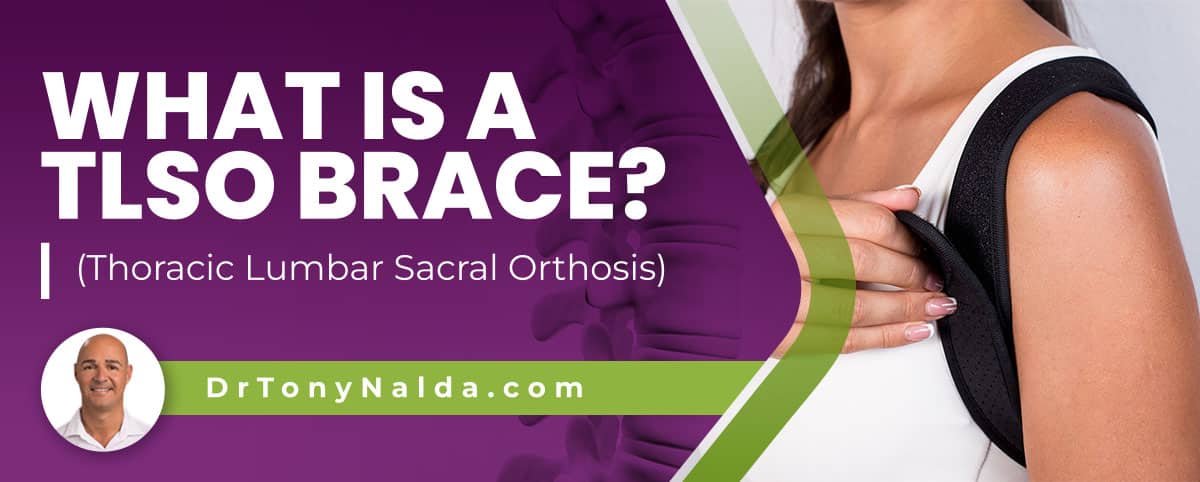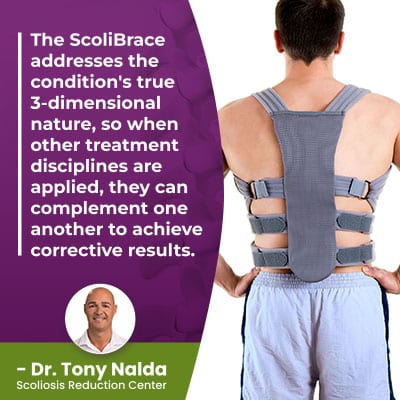What Is a TLSO Brace? (Thoracic Lumbar Sacral Orthosis)

Scoliosis bracing can be an effective facet of treatment, but to be clear, no brace on its own can correct a scoliosis, but when combined with other types of treatment, scoliosis bracing can help reposition the spine.
Scoliosis bracing is a facet of scoliosis treatment, and a TLSO brace is a thoracic lumbar sacral orthosis brace that's used to limit spinal movement and progression. There are a number of different scoliosis braces that can be used in treatment, and not all are created equal.
Let's start our discussion of TLSO braces with how scoliosis is diagnosed, along with some defining condition characteristics.
Table of Contents
Diagnosing Scoliosis
Diagnosing scoliosis means an unnatural sideways spinal curve that also twists has developed, and scoliosis ranges widely in severity from mild to moderate and severe to very severe, and as a progressive condition, where a scoliosis is at the time of diagnosis doesn't mean that's where it will stay.
Scoliosis has it in its nature to get worse over time, and that means the size of the unnatural spinal curve is increasing, as are the condition's uneven forces, and their effects.
Diagnosing scoliosis also involves further classifying conditions based on key patient/condition variables that the customization of treatment plans are shaped around.
Diagnosing scoliosis means the patient's body is being exposed to a lot of uneven forces, and those uneven forces can cause a number of effects.
Scoliosis severity is determined by a measurement known as Cobb angle, and a patient's Cobb angle determines condition severity:
- Mild scoliosis: Cobb angle measurement of between 10 and 25 degrees
- Moderate scoliosis: Cobb angle measurement of between 25 and 40 degrees
- Severe scoliosis: Cobb angle measurement of 40+ degrees
- Very-severe scoliosis: Cobb angle measurement of 80+ degrees
As a progressive condition, scoliosis is incurable, but it can be highly treatable, and different treatment approaches, and different types of braces, have different treatment goals that impact spinal health differently.
Traditional Treatment and the TLSO Brace
Traditional scoliosis treatment involves a surgical response, and spinal fusion has the goal of stopping progression, and this is what traditional scoliosis treatment focuses on.
 Traditional scoliosis treatment doesn't have a strategy for addressing scoliosis while mild so does little to proactively prevent progression.
Traditional scoliosis treatment doesn't have a strategy for addressing scoliosis while mild so does little to proactively prevent progression.
TLSO braces stand for thoracic lumbar sacral orthosis, and there are three main sections of the spine: the cervical spine (neck), thoracic spine (middle/upper back), and the lumbar spine (lower back).
Scoliosis can develop in any of the spine's main sections or in more than one as a combined scoliosis, but the most common spinal section effected is the thoracic spine, which is the largest section.
There are different types of scoliosis, with the most prevalent being adolescent idiopathic scoliosis, diagnosed between the ages of 10 and 18, and bracing can be particularly effective on growing spines.
The theory behind a TLSO brace is that applying pressure to a growing spine can slow down its growth (movement) in the area; the goal of traditional bracing and treatment is to slow down, or stop, progression.
TLSO braces have pads that apply pressure along the spine to squeeze the spine unnaturally, and when/if a patient progresses to severe at 40+ degrees, this is commonly when spinal fusion surgery is recommended.
Who Uses a TLSO Brace?
As mentioned, the age group most commonly diagnosed with scoliosis is adolescents, and TLSO braces are a traditional facet of treatment for growing spines.
Bracing is used in the treatment of childhood scoliosis because growth is the main trigger for progression, so patients who have not yet reached skeletal maturity are the most at risk for rapid-phase progression.
The practice of attempting to slow progression with a brace isn't commonly used for adults because their spines are no longer growing so bracing won't be as effective; when braces are used in the treatment of adult scoliosis, it's more about providing short-term pain relief and helping to stabilize the spine.
TLSO braces are often prescribed for adolescents between the ages of 12 and 15 who have Cobb angle measurements of between 20 and 40 degrees (moderate scoliosis), and this can involve full-time wear which can mean anywhere from 13 to 23 hours a day for up to five years.
The Boston Brace
The most commonly used TLSO brace in the United States is the boston brace, and these are prescribed for full-time wear.
The boston brace is associated with a number of shortfalls that limit its potential efficacy; for example, because a scoliotic spine doesn't just bend unnaturally, but also twists, its rotational component makes it a 3-dimensional condition.
The boston brace doesn't address it as such, only impacting it in two dimensions, and ignoring the condition't rotational component only limits its potential effectiveness.
The boston brace is also a bulky and uncomfortable to wear because it's not bespoke to its wearer, and this contributes to compliance issues; no brace has any chance be effective unless it's worn exactly as prescribed, and if a brace is uncomfortable and bulky to wear, it's not going to be worn by teenagers who just want to fit in with their peers.
The boston brace works by squeezing the spine unnaturally, and this is known to weaken the spine over time, and wearing the boston is also associated with skin chafing, breathing troubles, and increased activity restrictions.
Fortunately, there is another modern treatment approach that favors a different type of brace, a corrective brace that addresses many of the shortfalls associated with the TLSO brace.
Conservative Treatment and the ScoliBrace
 Conservative scoliosis treatment offers a non-surgical alternative, and it has a different treatment goal than traditional treatment; it does want to manage progression, but its main goal is to actually correct a scoliosis.
Conservative scoliosis treatment offers a non-surgical alternative, and it has a different treatment goal than traditional treatment; it does want to manage progression, but its main goal is to actually correct a scoliosis.
Conservative treatment wants to impact the condition on a structural level because scoliosis is a structural condition, and it does so by responding to a diagnosis of scoliosis proactively and integrating multiple different forms of treatment into treatment plans.
Here at the Scoliosis Reduction Center, I want to start treatment as close to the time of diagnosis as possible because scoliosis only gets more complex to treat the more it progresses, and my brace of choice is the ScoliBrace.
While no brace on its own can correct a scoliosis, when corrective bracing is integrated into a proactive conservative treatment plan, it can help augment corrective treatment results by pushing the spine into a corrective position; this is different than squeezing the spine unnaturally.
In addition, the ultra-corrective ScoliBrace uses state-of-the-art scanning technology to ensure that every brace is custom-designed to address the specifics of a patient's body and curvature type, making the brace less bulky and more comfortable to wear: addressing compliance issues.
The ScoliBrace addresses the condition's true 3-dimensional nature, so when other treatment disciplines are being applied, they can complement one another to achieve corrective results.
Conclusion
A TLSO brace is a traditional scoliosis brace used in traditional scoliosis treatment, the most common of which is the boston brace, but the boston brace is associated with a number of shortcomings.
The ultra-corrective ScoliBrace used in conservative treatment represents the culmination of what we've learned about scoliosis, and bracing efficacy, over the years.
When integrated into a proactive conservative treatment plan that involves condition-specific chiropractic care, physical therapy, scoliosis-specific exercises, and rehabilitation, corrective bracing can help augment corrective treatment results by pushing the spine into a corrective position.
Here at the Center, I approach my adolescent idiopathic scoliosis patients proactively by starting treatment as close to the time of diagnosis as possible.
I want to work towards preventing progression, increasing condition effects, and the need for invasive surgical treatment in the future.
A spinal brace for scoliosis can be an effective means of adjusting the spine's position, but unless the condition is impacted on a structural level, this isn't the same as actually correcting a scoliosis, which is the goal of conservative scoliosis treatment.
A scoliosis brace can help keep the spine straight, and corrective braces like the ScoliBrace have straps evenly placed to facilitate normal breathing, is made from soft material, can provide support, improve posture, reduce pain, and can improve related postural changes such as uneven shoulders and hips.
For those undergoing traditional scoliosis treatment, it's important to understand how traditional TLSO braces can effect the spine, and when it comes to long-term spinal health and function, traditional treatment can cost the spine.
For those undergoing conservative scoliosis treatment, this approach uses a corrective brace for its corrective potential, and combines it with other proactive treatment disciplines, that can address scoliosis while preserving as much of the spine's natural strength and function as possible.
Dr. Tony Nalda
DOCTOR OF CHIROPRACTIC
After receiving an undergraduate degree in psychology and his Doctorate of Chiropractic from Life University, Dr. Nalda settled in Celebration, Florida and proceeded to build one of Central Florida’s most successful chiropractic clinics.
His experience with patients suffering from scoliosis, and the confusion and frustration they faced, led him to seek a specialty in scoliosis care. In 2006 he completed his Intensive Care Certification from CLEAR Institute, a leading scoliosis educational and certification center.
About Dr. Tony Nalda
 Ready to explore scoliosis treatment? Contact Us Now
Ready to explore scoliosis treatment? Contact Us Now





